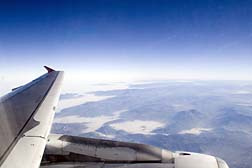Gut-dropping images caught on amateur video of its runway approach, show the left wing of the Airbus A320 grazing the runway; the aircraft teeters, then lifts off and returns for a successful landing. Wolfgang Weber, a spokesman for Lufthansa, praised the pilots for their "absolutely professional maneuver. It was a dicey situation. People were quite shaken." The German Federal Bureau of Aircraft Accidents Investigation is examining why the runway was in use during such strong winds.
 Downdrafts, mountain waves, crosswind, tailwinds and the sudden, shifting gusts and change in wind speed, known as wind shear, have been implicated in numerous plane crashes around the world. But it is the microburst wind shear that is the most feared. It occurs at low altitudes, typically during take-off and landings, and most often during thunderstorms.
Downdrafts, mountain waves, crosswind, tailwinds and the sudden, shifting gusts and change in wind speed, known as wind shear, have been implicated in numerous plane crashes around the world. But it is the microburst wind shear that is the most feared. It occurs at low altitudes, typically during take-off and landings, and most often during thunderstorms.Thunderstorms are a common element in microburst wind shear accidents. The plane penetrates a large column of cold dense air that is rushing downward then fanning outward as it hits the earth. The mixing of air forms a rolling vortex of high velocity air gusting out to form horizontal wind shear. Caught in the vortex, the aircraft loses airspeed and the pilot's experience is severely challenged, as demonstrated in the Lufthansa near-miss.
Although wind shear detection has been under the radar of researchers since 1948, it took a trio of crashes in the 1970s and '80s to spark a new generation of wind shear detection technology.
Delta Airlines Flight 191 was caught in a microburst wind shear at Dallas-Fort Worth International Airport on August 2, 1985, struck the ground, killing all 163 aboard.
That crash came too quickly on the heels of an accident involving a Pan American World Airways jet taking off from New Orleans International Airport three years early. It encountered severe wind shear just 800 feet off the ground and crashed, taking 153 lives.
"Wind shear" suddenly became a household word and members of Congress were flooded with calls to do something to prevent further accidents. These incidents became the catalyst for Federal Aviation Administration (FAA), NASA and several other organizations to boost their wind shear program and to continually improve the forecasting and detection technology.
Into the picture was introduced the Low Level Wind Shear Alert System (LWSAS), developed in response to the first major crash attributed to microburst wind shear-- the Eastern Airlines flight 66 crash in New York in 1975. LWSAS measures wind speed and direction at remote stations around an airport. Now installed in airports across North America and the world are third generation LWSAS, and the newer Terminal Doppler Weather Radar, a rotating 'pencil beam' detecting windblown objects that indicate a sudden change in wind direction as well as abrupt changes in moisture and moisture.
Although onboard wind shear warning systems are mandatory by the FAA, like all technology, no system is foolproof.
In the September 16, 2007 budget airline One-Two-Go crashed during landing on the island resort of Phuket, in Thailand. The McDonnell Douglas MD-82 jetliner, owned by Orient-Thai Airlines, skidded off the runway in heavy rain and wind, then ran through a low retaining wall and split in two, killing 89 people.
A safety director at the department of civil aviation told the AlJazeera Network that, "Initial assumption is that the wind shear detection system of Phuket airport was not fully operational at the time the accident occurred. We checked today [Tuesday], and just found that the system didn't respond to the control tower." The aircraft was equipped with an on-board wind shear warning system.
READ MORE LEGAL NEWS
Other plane crashes related to microburst wind shear include:
Peru August 24, 2005 - an attempted emergency landing in stormy weather, where the pilot did not report mechanical difficulties and a survivor said there was no warning.
USAir Flight 1016 in July 1994 - pilots tried to abort a landing of DC-9 at Charlotte/Douglas Airport during torrential rains and gusting winds, when, a National Transportation Safety Board spokesman says, the plane was slammed to the ground in a fashion consistent with wind shear effect.
